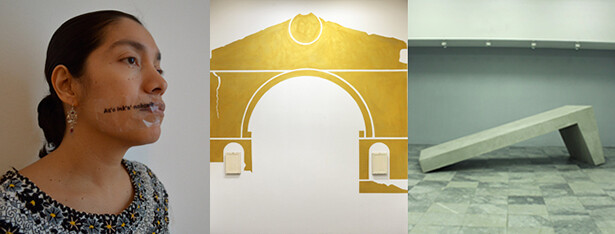Academy of Fine Arts Vienna
Schillerplatz 3
1010 Vienna
Austria
www.akbild.ac.at
Flaka Haliti, Hristina Ivanoska, Sandra Monterroso, PhD-in-Practice students, and Heimo Zobernig, professor of textual sculpture—all four of them from the Academy of Fine Arts Vienna—will exhibit in the pavilions of their home countries at the 56th Venice Biennale.
This kind of recognition is something to be proud of: three students in the PhD-in-practice program at the Academy are taking part in this year’s Venice Biennale. And not as “supporting artists” in the themed exhibition, but as official representatives of their home countries. That is, if one can speak of representation at all in this context.
That very issue is subject of Sandra Monterroso’s contribution to the Latin-American collective pavilion. In her sound installation Rokeb’ iq’ / Wind, the Guatemalan artist explores the indigenous dialects that are still spoken in Guatemala today but are at the same time suppressed in favor of the official language, Spanish. A total of 15 sound pieces will be played in the pavilion of the IILA (Instituto Italo-Latinoamericano), presented without images as one big intermeshing cacophony, from which, upon approaching each speaker, individual indigenous voices of the continent emerge. With her onomatopoeic example of the language, the artist reminds us that even today many Guatemalans who move from the countryside to the cities suppress their own native languages in order to avoid racially motivated ostracism. This ostracism is reinforced as well on another level: by the failure to officially acknowledge the genocide perpetrated mainly against the Mayan people during the civil war that took place between 1960 and 1996. Monterroso does not aim to represent this unresolved horror with her sound piece but rather—taking things one step further—to work toward a sort of recovery process through her poetic and metaphorical evocation.
Another topos that is increasingly suppressed in Western contexts—namely that of faith and holiness—is the subject of the contribution by the Macedonian artist and Academy student Hristina Ivanoska in collaboration with her partner Yane Calovski. Ivanoska and Calovski have adapted their project We are all in this alone, shown last year at the Staatliche Kunsthalle in Baden-Baden under the title Chapel, for the Macedonian pavilion. Serving as architectural springboard for the project was the 12th-century Church of St. Gjorgi Kurbinovo and its extravagant Byzantine frescoes. The artists “transferred” these—abstracted and spatially remodeled—into a golden wall illustration, which in turn is embellished with a series of objects, collages, and other graphic elements. Texts by the philosophers Simone Weil and Luce Irigaray as well as the artist Paul Thek serve as spiritual sources. The theme is also underlined by the title of the exhibit: We are all in this alone—connoting the maximum of existential powerlessness and desolation, which could at any moment transmute into a need for transcendence, take whatever form it may.
Flaka Haliti deals with a different kind of transcendence in her artwork for the Kosovo pavilion. Haliti, who, together with the pavilion’s curator, Nicolaus Schafhausen, is pursuing a determined strategy of secrecy, intends to expand on her two solo exhibitions from last year: I See a Face. Do You See a Face, shown at MUMOK in Vienna in celebration of her winning the Henkel Art Award in 2013, as well as Last time when I googled you, you looked different at the National Gallery of Kosovo in Priština. Each exhibition included certain core elements that are now being reimagined for the Venice format. These include, for one, the photographs of amorphous cloud formations, implicating that the endless and distant always holds a concrete promise hidden within. For the other, Haliti recreates cement blocks like the real ones protectively encircling the UNMIK headquarters in Priština—as if this germ cell of the peace mission must first be “deterritorialized” before it can attain a more widespread political validity. Deterritorialization is also to be applied to the idea of nation-state pavilions itself through Haliti’s expansive multimedia installation bearing the title Speculating on the blue. Exactly how will not be made known in advance, only that the exhibit also relates to Okwui Enwezor’s themed exhibition All the World’s Futures, in particular its section “Garden of Disorder.” Which blue Haliti is aiming for in her reinterpretation of territorial conflicts—the national color of Kosovo, the blue of the UN, or the blue of the borderless utopia—all that remains to be seen. But it is precisely this question, this tendency to come “out of the blue,” that portends yet another transgression of any principle of representation. With—this much is certain—an unpredictable outcome.
As well, the celebrated artist and lecturer at the Academy of Fine Arts Vienna, Heimo Zobernig, will be exhibiting in the Austrian pavilion at the 56th Venice Biennale. And last but not least, Monica Bonvicini, professor of performative art & sculpture since 2003, will be represented at Venezia for the fourth time. She will show a series of new sculptures in the exhibition All the World’s Futures at the Arsenale, curated by Okwui Enwezor.
Text: Christian Höller, editor and co-publisher of the magazine springerin—Hefte für Gegenwartskunst.
*Left: Sandra Monterroso, Self-Portrait. © Photo: Sandra Monterroso. Center: Hristina Ivanoska and Yane Calovski, Chapel (we are all in this alone), Staatliche Kunsthalle Baden-Baden. Photo: Michael Belogour. Right: from the exhibition Flaka Haliti—Last time when I googled you, you looked different, National Gallery of Kosovo. Photo: Enver Bylykbashi. © National Gallery of Kosovo.



